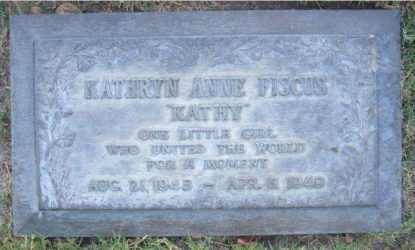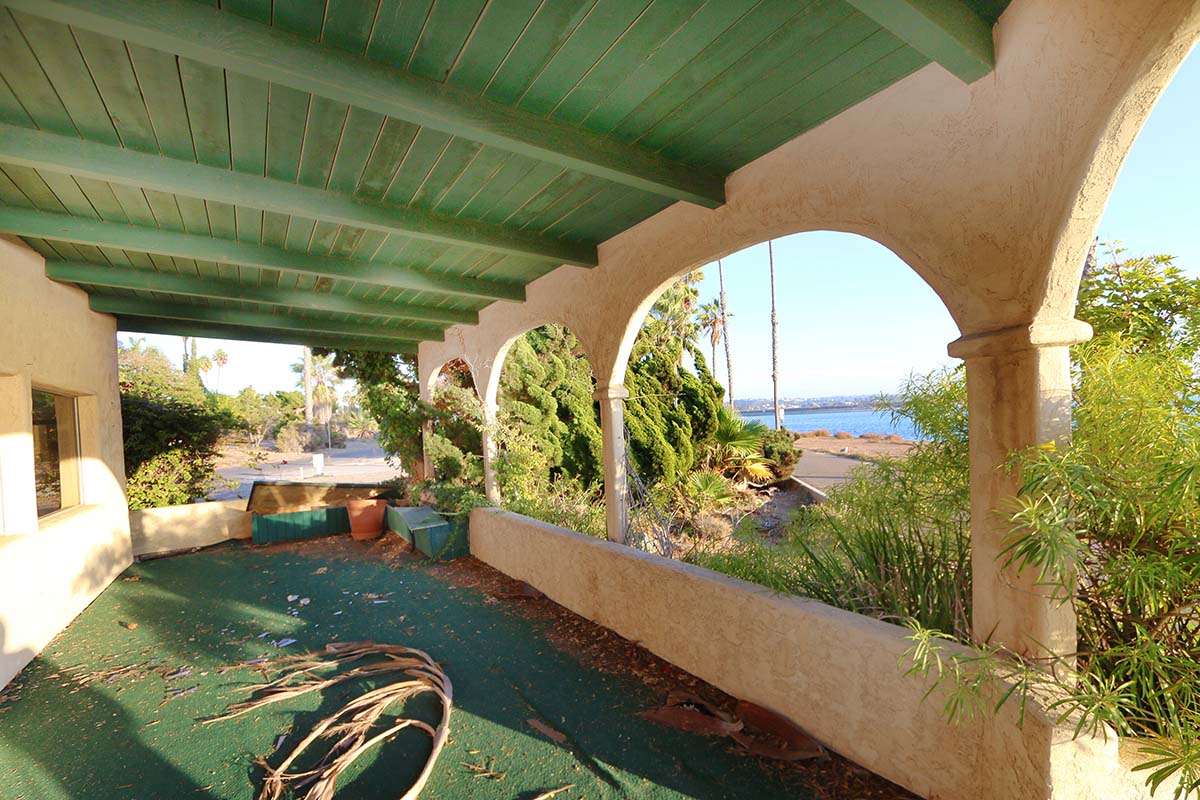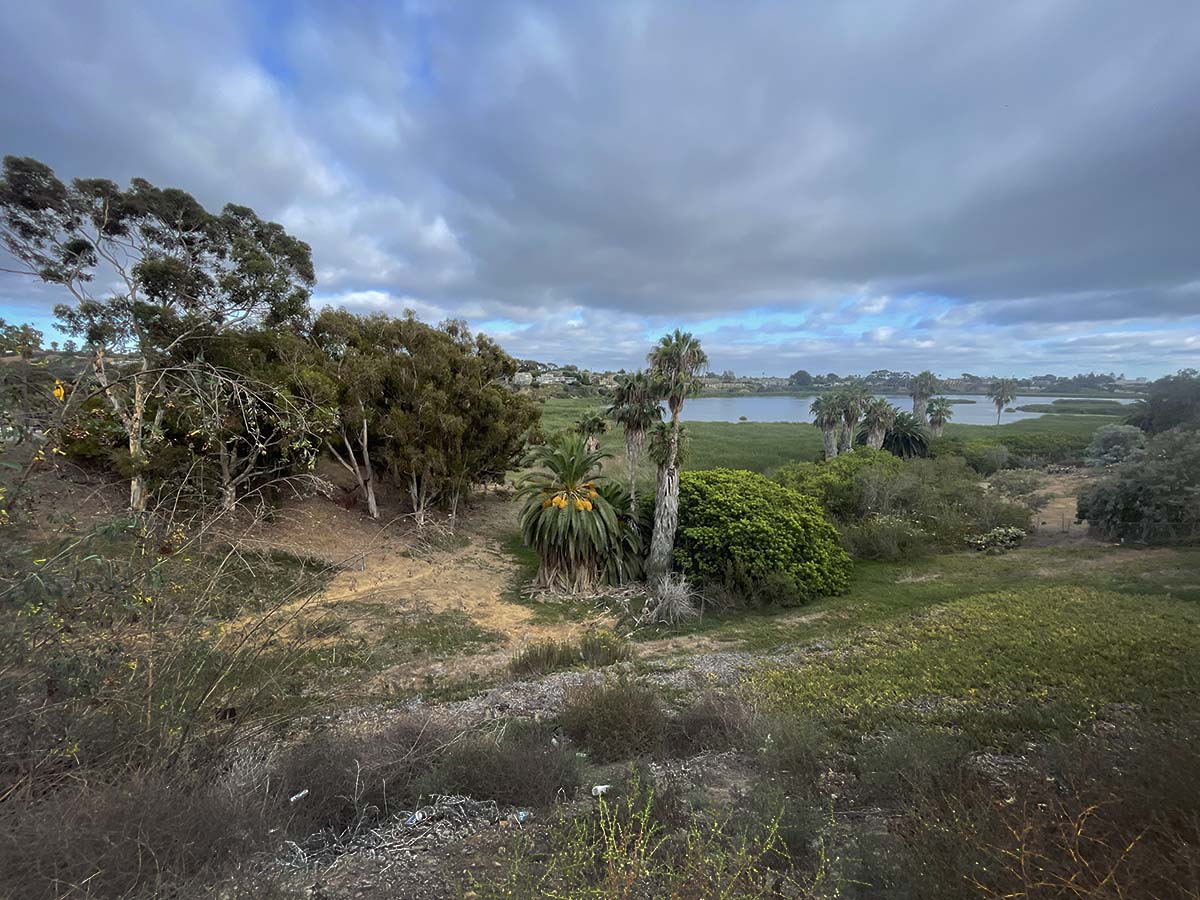
The Grave of Kathy Fiscus
Article by David Johnson:

It had all of the elements of an unspeakably wrenching tragedy. An adorable three year old girl fell into a dry, abandoned well in a Los Angeles suburb and despite the heroic efforts of an army of frantic volunteers, died in the well medium of television, and for three awful days it captivated much of the world. And the story ends in South San Diego County where the child is laid to rest at Glen Abbey Memorial Park in Bonita.
Kathryn Ann Fiscus was born on August 21, 1945; six days after Japan surrendered to officially end World War II. On the afternoon of April 8, 1949; she was playing in a field in the Los Angeles County community of San Marino with her sister and a cousin when she suddenly disappeared. She had fallen down an abandoned water well whose entrance was concealed by weeds. That well had been drilled in 1904 to access water from the Raymond Aquifer to irrigate nearby citrus trees, but it had now passed into disuse. The well’s wooden cover had recently been dislodged by a plow or mower. In one of the profound ironies surrounding this case, Kathy’s father, David Fiscus, worked for a water company, and had just returned from giving testimony before a legislative committee in support of a law to require the cementing of unused wells.
Kathy’s mother Alice rushed to the scene and could hear Kathy’s faint calls from deep in the well. In the fifty hours that followed, a variety of methods were considered as some 100 workers tried desperately to save the child. A rope was lowered into the well in hopes that a slip knot could grasp her and pull her to the surface. There was a discussion of using suction to draw her to the surface, or filling the well with water to float her up. They even contemplated lowering a dwarf into the well face first to pull her up. But in the end it was parallel shafts drilled near the well that ultimately enabled rescuers to reach her, just as others did nearly thirty years later in the rescue of toddler Jessica McClure in Midland Texas. Only this time there would be no happy ending.
Two rescue shafts were drilled on either side of the well. By Saturday the larger of the two had been excavated to a depth of 65 feet and a lateral tunnel was bored through the well’s casing. A worker who crawled through that tunnel reported that he thought he had seen the child’s dress, and estimated she was wedged at a depth of about 95 feet. On the other side, a narrower 24-inch shaft was drilled to a depth of 93 feet.

The unstable nature of the second shaft now necessitated the removal of drilling equipment. The final ten feet of the shaft were dug by hand by brave volunteers who worked in shifts under the constant risk of cave-in and certain death. They again tunneled through to the well and this time reached Kathy and passed up the heartbreaking news that she was dead. An hour later, after she was moved through the tunnel to the rescue shaft, her little body was wrapped in a blanket and borne to the surface by a heroic sewer contractor named Bill Yancy who had worked multiple shifts in the rescue shaft. In the latter stage of the rescue attempt, an estimated 10,000 anxious spectators lined the site.
In the aftermath of the failed rescue Alice Fiscus received letters of condolence from nearly every country in the world except the Soviet Union. The changes the event produced for media coverage of news stories were profound. Television station KTLA in Los Angeles broadcast live from the rescue site for more than 27 hours, and in the words of Los Angeles Times reporter Patt Morrison, turned television from a toy to a tool. A man named Cecil Smith passed a department store on his way home at 2:00 AM and reported seeing a hundred people gathered in front of the store window watching a television tuned to the rescue. In the months after the tragedy, state after state passed measures that required sealing of unused wells.
Within weeks a country artist named Jimmie Osborne recorded a song called ‘The Death of Little Kathy Fiscus.” The song reportedly sold more than one million copies and it became a top ten hit. The song is linked below. The field where Kathy Fiscus died is now part of an athletic field on the campus of San Marino High School. While the site is unmarked, her legacy endures in that community.
 The unstable nature of the second shaft now necessitated the removal of drilling equipment. The final ten feet of the shaft were dug by hand by brave volunteers who worked in shifts under the constant risk of cave-in and certain death. They again tunneled through to the well and this time reached Kathy and passed up the heartbreaking news that she was dead. An hour later, after she was moved through the tunnel to the rescue shaft, her little body was wrapped in a blanket and borne to the surface by a heroic sewer contractor named Bill Yancy who had worked multiple shifts in the rescue shaft. In the latter stage of the rescue attempt, an estimated 10,000 anxious spectators lined the site.
The unstable nature of the second shaft now necessitated the removal of drilling equipment. The final ten feet of the shaft were dug by hand by brave volunteers who worked in shifts under the constant risk of cave-in and certain death. They again tunneled through to the well and this time reached Kathy and passed up the heartbreaking news that she was dead. An hour later, after she was moved through the tunnel to the rescue shaft, her little body was wrapped in a blanket and borne to the surface by a heroic sewer contractor named Bill Yancy who had worked multiple shifts in the rescue shaft. In the latter stage of the rescue attempt, an estimated 10,000 anxious spectators lined the site.
In the aftermath of the failed rescue Alice Fiscus received letters of condolence from nearly every country in the world except the Soviet Union. The changes the event produced for media coverage of news stories were profound. Television station KTLA in Los Angeles broadcast live from the rescue site for more than 27 hours, and in the words of Los Angeles Times reporter Patt Morrison, turned television from a toy to a tool. A man named Cecil Smith passed a department store on his way home at 2:00 AM and reported seeing a hundred people gathered in front of the store window watching a television tuned to the rescue. In the months after the tragedy, state after state passed measures that required sealing of unused wells.
Within weeks a country artist named Jimmie Osborne recorded a song called ‘The Death of Little Kathy Fiscus.” The song reportedly sold more than one million copies and it became a top ten hit. The song is linked below. The field where Kathy Fiscus died is now part of an athletic field on the campus of San Marino High School. While the site is unmarked, her legacy endures in that community.
There are large numbers of women now in their sixties who report being named Kathy by parents who were honoring Kathy Fiscus. The typical entry on the Find a Grave website might contain one or two tributes. As we approach what would be Kathy Fiscus’ seventieth birthday, her entry has well over 1,000 comments and many are passionate and filled with emotion.
The child is buried In Glen Abbey Memorial Park just a few feet away from former California State Senator Jack Schrade, a figure of some local renown who served in the legislature between 1954 and 1978. His name is given to the freeway bridge where Highway 805 crosses over Highway 8.
To reach the cemetery and grave, take the Bonita Road off-ramp from the 805 freeway and go east for about half a mile. The entrance to the cemetery is on the right side of the road and it comes up fairly suddenly. You first pass through the gates pictured at right and take the right fork in the road a few dozen yards from the gate. That road is named Sleep Hollow Lane and it curves to reveal the Sleepy Hollow Mausoleum which stretches along for a number of yards to the left of the street.
The grave is located in the grassy area between the street and the mausoleum, and is perhaps thirty feet from the road. The day we were there it was shaded by trees that are located next to the street. A view from that street to the structure is pictured at
right and Kathy’s grave is in the middle of the second row from the bottom. If you reach the graves of the Schrade family, you have gone too far to the right. Her grave bears the inscription, “ONE LITTLE GIRL WHO UNITED THE WORLD FOR A MOMENT.” It is not an overstatement. More than 65 years after she died, you can google her name and get more than 100,000 links in a quarter of a second. To many people in their late sixties and older, the event is an enduring memory.
On the day we visited, the staff members at Glen Abbey Mortuary were incredibly warm and helpful to us. They gave us a photocopy of the cemetery’s index card that is the official record of Kathy’s interment, and a staff member led us to the precise site of her grave. They did not realize the amount of history behind the little girl in the grave, or how famous she had been at one time. Along with Kathy, the most celebrated resident of the cemetery is probably hydroplane racer Bill Muncey, who died at the age of 52 from injuries suffered in a racing accident in Mexico in 1981. For anyone interested in the layout of the cemetery, it is pictured at the end of this article along with an image of Kathy Fiscus’ grave marker.
It is hard now to grasp what an important event the death of Kathy Fiscus was, or what it said about the changing realities regarding the value of a single human life. We were less than four years removed from the end of World War II, a catastrophic conflict that saw literally millions of children slaughtered by bombs, gas, disease and starvation, and all of the great powers were a party to the carnage. But for three days in 1949, the world united around the premise that the life of a single child was now sufficiently valuable to capture the attention and emotions of much of the world.
The tragedy played out when I was nine months old, and by coincidence, my sister was also named Kathryn Ann. From my earliest days I can recall my parents referring to her as “little Kathy not in the well,” an expression of the trauma felt by complete strangers over the tragedy. They and many other American parents held their daughters tighter in unspoken relief that this had happened to someone else’s child.
Kathy’s death was not the end of tragedy for people associated with the event. Songwriter Jimmie Osborne died from a self-inflicted gunshot wound the day after Christmas in 1958. He was 35, and had just had an argument with his wife. Six months earlier, rescue operation hero Bill Yancey died when a trench he was inspecting caved in less than two miles from the site of the Fiscus tragedy. The Los Angeles Times reported his demise under the heading, “Death of a Hero.”
There are large numbers of women now in their sixties who report being named Kathy by parents who were honoring Kathy Fiscus. The typical entry on the Find a Grave website might contain one or two tributes. As we approach what would be Kathy Fiscus’ seventieth birthday, her entry has well over 1,000 comments and many are passionate and filled with emotion.
The child is buried In Glen Abbey Memorial Park just a few feet away from former California State Senator Jack Schrade, a figure of some local renown who served in the legislature between 1954 and 1978. His name is given to the freeway bridge where Highway 805 crosses over Highway 8.
To reach the cemetery and grave, take the Bonita Road off-ramp from the 805 freeway and go east for about half a mile. The entrance to the cemetery is on the right side of the road and it comes up fairly suddenly. You first pass through the gates pictured at right and take the right fork in the road a few dozen yards from the gate. That road is named Sleep Hollow Lane and it curves to reveal the Sleepy Hollow Mausoleum which stretches along for  a number of yards to the left of the street.
a number of yards to the left of the street.
The grave is located in the grassy area between the street and the mausoleum, and is perhaps thirty feet from the road. The day we were there it was shaded by trees that are located next to the street. A view from that street to the structure is pictured at
right and Kathy’s grave is in the middle of the second row from the bottom. If you reach the graves of the Schrade family, you have gone too far to the right. Her grave bears the inscription, “ONE LITTLE GIRL WHO UNITED THE WORLD FOR A MOMENT.” It is not an overstatement. More than 65 years after she died, you can google her name and get more than 100,000 links in a quarter of a second. To many people in their late sixties and older, the event is an enduring memory.
On the day we visited, the staff members at Glen Abbey Mortuary were incredibly warm and helpful to us. They gave us a photocopy of the cemetery’s index card that is the official record of Kathy’s interment, and a staff member led us to the precise site of her grave. They did not realize the amount of history behind the little girl in the grave, or how famous she had been at one time. Along with Kathy, the most celebrated resident of the cemetery is probably hydroplane racer Bill Muncey, who died at the age of 52 from injuries suffered in a racing accident in Mexico in 1981. For anyone interested in the layout of the cemetery, it is pictured at the end of this article along with an image of Kathy Fiscus’ grave marker.
It is hard now to grasp what an important event the death of Kathy Fiscus was, or what it said about the changing realities regarding the value of a single human life. We were less than four years removed from the end of World War II, a catastrophic conflict that saw literally millions of children slaughtered by bombs, gas, disease and starvation, and all of the great powers were a party to the carnage. But for three days in 1949, the world united around the premise that the life of a single child was now sufficiently valuable to capture the attention and emotions of much of the world.
The tragedy played out when I was nine months old, and by coincidence, my sister was also named Kathryn Ann. From my earliest days I can recall my parents referring to her as “little Kathy not in the well,” an expression of the trauma felt by complete strangers over the tragedy. They and many other American parents held their daughters tighter in unspoken relief that this had happened to someone else’s child.
Kathy’s death was not the end of tragedy for people associated with the event. Songwriter Jimmie Osborne died from a self-inflicted gunshot wound the day after Christmas in 1958. He was 35, and had just had an argument with his wife. Six months earlier, rescue operation hero Bill Yancey died when a trench he was inspecting caved in less than two miles from the site of the Fiscus tragedy. The Los Angeles Times reported his demise under the heading, “Death of a Hero.”








Bobbe Ashley Kjellin
I remember the accident when I was 14 in 1949.I lived in East Pasadena. I have talked to two class mates of mine since high school and they were there at the scene. One lived in San Marino and the other in South Pasadena.
Many years later in 2015 I contacted Professor Bill Deverell and told him that I remember the accident and that my former mother -in- law Helen Yancy Ashley, was the sister of Bill
Yancy the hero of the day who brought up Kathy.
In 3 days we will celebrate the “70th” Birthday of Kathy on the 21st of August 2015.I was born on the 21st of June 1935.
I feel some kind of connection through family and time.
I live in Vista Ca. and will go and visit Kathy at her resting
place.
Kathy Barberi
I am searching for the family of Kathy Fiscus if they would not mind. My mission is putting wells in around the world. I would love to talk to the family about this. I really hope to get a response
D McCulley
I was born in 1945 and I remember Kathy’s death. I learned the song and I would sing it for my
Grandmother. I remember feeling sad because of being close to her age. Living in rural Alabama
we had a well so I knew about how deep and dark they are. It still saddens me until this day.
Kathleen Hope
I am in my 70s now, but was 10 years old at the time. It was a huge story with almost minute by minute coverage. I remember being frustrated by having had an eye exam during the time of efforts to reach her and pupils dilated, was unable to read the latest news in the paper about the case. I had no idea at the time (or since) that this was as broadly known about. I never forgot her name, and because of the internet am able to take a look back at the case. What a horrible experience it must have been for her family. RIP little Kathy
Norman Schultz
I am 81 now but as a 14-year-old when I watched the rescue events and listened to Stan Cambers KTLA broadcasts. I, like the world was very sad when she was found to have died. As an adult while working for the Los Angeles City Fire Department I met Stan Chambers and spoke with him about the tragedy. Even after so many years it brought tears to his eyes. After 66 years I still think of her from time to time. She captured the hearts of the world at a kinder time in history.
keri 9 years old
very sad three years old girl died in front of my eyes. poor girl
Anonymous
poor girl
John R. Pardieck, Sunland Ca.
I was 10 years old, and watched the rescue efforts on my Uncle’s television.
I prayed for her rescue, and cried when she died.
The Minister of our church came to our Sunday School and discussed what had happened, and why.
It alleviated the guilt that many of us had, that maybe we did not pray hard enough
Whenever I think about it, I still get tears in my eyes.
JAY SMITH
I was 14 years old in 1949, and living in Portsmouth, VA. There was no TV station yet in the Norfolk area. We listened to every breathless minute on the radio. It was a haunting experience that I have never forgotten.
CATHERINE WHITE
“…..and by coincidence, my sister was also named Kathryn Ann.”
I’m sure not a coincidence at all. My name is Catherine; and I was born on June 14, 1949, two months after Kathy’s death. I was named after her, as many little girls in San Diego were, for the next 10 years. As I was growing up, in almost every one of my classes, in grade school, there were at least 2 Cathy’s if not more.
Anonymous
James Ronnie Green